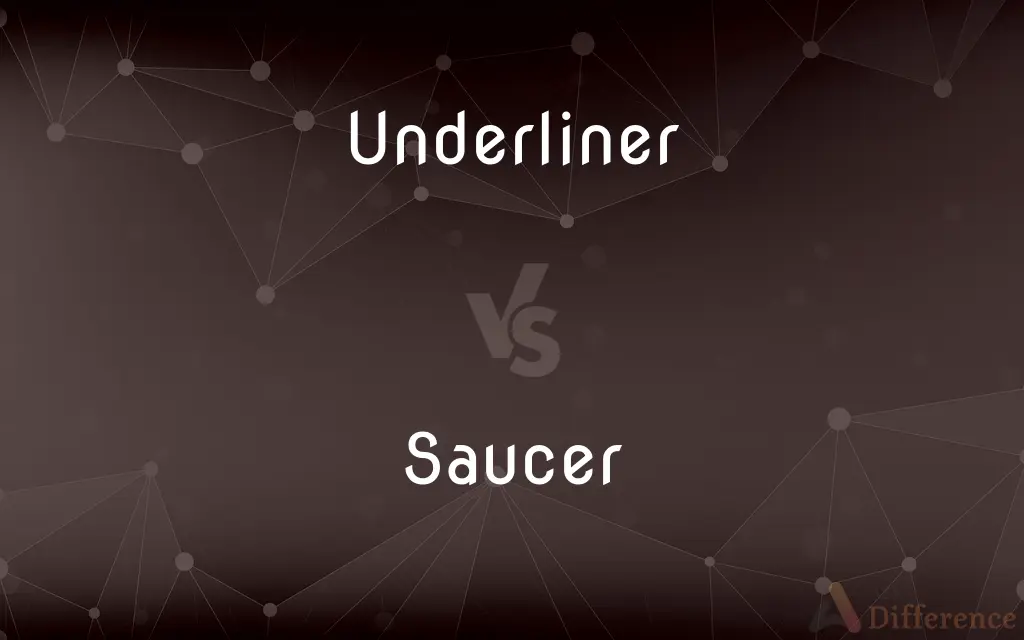Underliner vs. Saucer — What's the Difference?
By Maham Liaqat & Fiza Rafique — Updated on April 2, 2024
Underliners are supports for plates or dishes, enhancing presentation, while saucers are small, shallow dishes designed to hold a cup.

Difference Between Underliner and Saucer
Table of Contents
ADVERTISEMENT
Key Differences
An underliner serves primarily as a base for a plate, bowl, or dish, providing stability and adding an aesthetic element to the table setting. It's used in various dining contexts to protect the table or cloth from heat, spills, or scratches. Saucers, on the other hand, are specifically designed to accompany a cup, typically for tea or coffee, catching any spills, holding a used tea bag, or even a biscuit.
Underliners can be made from a variety of materials, including wood, metal, or ceramic, depending on the setting and the level of formality. They might not always be in direct contact with food. Saucers are usually made from the same material as their matching cups, forming a set, and are always food-safe, often echoing the cup's design.
The concept of an underliner is broader and can apply to any dish or container that needs a base for aesthetic or practical reasons. This makes underliners versatile and usable in multiple dining scenarios, from casual to formal. Saucers have a more defined role, specifically in tea or coffee service, and their design is tailored to the size and shape of the cup they are meant to support.
While the primary function of underliners is to enhance presentation and protect the dining surface, saucers also play a role in the etiquette of tea and coffee drinking. The presence of a saucer is a nod to tradition and manners, particularly in more formal settings or in cultures with a strong tea-drinking heritage.
Underliners and saucers differ in their historical origins as well. Underliners evolved from the practical need to protect surfaces and add to the visual appeal of a meal. Saucers, however, have a more specific origin tied to the European adoption of tea and coffee drinking, reflecting the cultural practices around these beverages.
ADVERTISEMENT
Comparison Chart
Primary Function
Supports and enhances presentation of plates or dishes.
Holds a cup, catching drips and holding tea accessories.
Material
Varied (wood, metal, ceramic).
Usually matches the cup (porcelain, ceramic).
Context
Versatile, used in multiple dining scenarios.
Specifically for tea or coffee service.
Design
Broad, varies with dining ware.
Tailored to match the cup's design and size.
Role in Etiquette
Enhances table presentation and protects the dining surface.
Integral to tea and coffee drinking etiquette.
Compare with Definitions
Underliner
Used in both casual and formal dining situations.
At the banquet, each dish was served on a polished silver underliner.
Saucer
A small dish designed to support a cup, especially for tea or coffee.
He placed his espresso cup back on the saucer after each sip.
Underliner
A base or support for dishes, enhancing table presentation.
The wooden underliner complemented the rustic table setting.
Saucer
Often part of a matching set with the cup.
The porcelain saucer matched the delicate teacup perfectly.
Underliner
Can be made from a wide range of materials.
The ceramic underliners added a touch of elegance to the dinnerware.
Saucer
For catching drips and holding tea or coffee accessories.
The saucer held the used lemon wedge and tea spoon.
Underliner
Primarily for aesthetic appeal and surface protection.
Glass underliners were used to protect the linen tablecloth.
Saucer
Tied to the history of tea and coffee consumption.
The saucer's design was reminiscent of 18th-century English tea service.
Underliner
Suitable for various types of dishes and settings.
For the outdoor event, durable plastic underliners were chosen.
Saucer
Reflects traditional tea and coffee service manners.
She carefully lifted her cup from the saucer without clinking.
Underliner
One who underlines.
Students who are habitual underliners
Saucer
A saucer is a type of small dishware. While in the Middle Ages a saucer was used for serving condiments and sauces, currently the term is used to denote a small plate or shallow bowl that supports a cup – usually one used to serve coffee or tea.
Underliner
A liner or lining that goes underneath.
Saucer
A small shallow dish having a slight circular depression in the center for holding a cup.
Saucer
An object similar in shape to a saucer.
Saucer
A small shallow dish to hold a cup and catch drips.
Saucer
An object round and gently curved, shaped like a saucer.
The saucer-shaped object could have been a UFO.
Saucer
A circular sled without runners.
Saucer
(obsolete) A small pan or other vessel-like food container in which sauce was set on a table.
Saucer
A flat, shallow caisson for raising sunken ships.
Saucer
A shallow socket for the pivot of a capstan.
Saucer
(transitive) To pour (tea, etc.) from the cup into the saucer in order to cool it before drinking.
Saucer
(intransitive) Of the eyes: to become large and round.
Saucer
A small pan or vessel in which sauce was set on a table.
Saucer
A small dish, commonly deeper than a plate, in which a cup is set at table.
Saucer
Something resembling a saucer in shape.
Saucer
Something with a round shape like a flat circular plate
Saucer
A small shallow dish for holding a cup at the table
Saucer
Directional antenna consisting of a parabolic reflector for microwave or radio frequency radiation
Saucer
A disk used in throwing competitions
Common Curiosities
How does a saucer function in tea or coffee service?
It holds the cup, catches drips, and can hold accessories like tea bags or spoons.
What is the purpose of an underliner?
To support and enhance the presentation of dishes, while protecting the table surface.
How do the materials of underliners and saucers differ?
Underliners can be made from a broader range of materials, while saucers are usually made from the same material as their cups.
Can underliners be used with any type of dish?
Yes, they are versatile and can be matched with various dishes for aesthetic or practical reasons.
What role does an underliner play in dining etiquette?
It enhances table presentation and helps protect the dining surface, contributing to the overall dining experience.
Is there a cultural significance to using saucers?
Yes, saucers are part of the traditional etiquette associated with tea and coffee drinking, reflecting historical and cultural practices.
What considerations should be made when choosing underliners or saucers?
Considerations include material, design, the occasion's formality, and how they complement the rest of the dining ware.
Are saucers necessary for all types of cups?
While not necessary for all cups, saucers are traditional for tea and coffee cups, especially in formal settings.
Can the design of saucers vary according to the type of cup?
Absolutely, saucers are designed to match the size, shape, and style of their accompanying cups.
How do underliners enhance a dining experience?
They add an extra layer of detail to the presentation of meals and protect the table from damage or stains.
Share Your Discovery

Previous Comparison
Economics vs. Econometrics
Next Comparison
Stargate vs. PortalAuthor Spotlight
Written by
Maham LiaqatCo-written by
Fiza RafiqueFiza Rafique is a skilled content writer at AskDifference.com, where she meticulously refines and enhances written pieces. Drawing from her vast editorial expertise, Fiza ensures clarity, accuracy, and precision in every article. Passionate about language, she continually seeks to elevate the quality of content for readers worldwide.














































